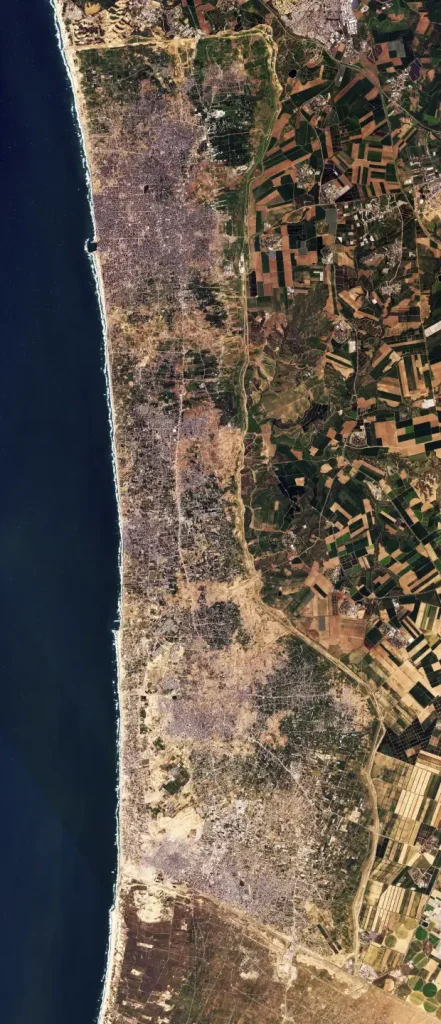The recent developments along the Gaza Strip’s border with Israel have sparked significant concern and debate.
Satellite images have revealed a 1-kilometer-deep path of demolition, indicating Israel’s intention to establish a buffer zone in the area.
This move has raised international objections and further exacerbated the already complex land disputes between Israel and the Palestinians.
The destruction along the border is just one aspect of the extensive damage inflicted on Gaza during the Israel-Hamas war.
Reports suggest that approximately half of all buildings within the coastal enclave have been damaged or destroyed, underscoring the widespread impact of the conflict.
Israeli authorities have expressed their desire to create a buffer zone as a defensive measure, citing the need to prevent future cross-border attacks by Hamas.
Despite warnings from the United States against reducing Gaza’s territory, Israel has proceeded with its plans.
The Israeli military, while acknowledging the demolition of buildings in the area, has refrained from confirming the establishment of a buffer zone when questioned by the Associated Press.
The proposed buffer zone, if implemented, would encroach upon approximately 60 square kilometers of land in the Gaza Strip, significantly reducing the territory available to Palestinians.
The southern part of the strip, particularly near the town of Khirbet Khuzaa, has already witnessed extensive destruction of farmland and buildings, raising doubts about the temporary nature of the proposed buffer zone.
In addition to the physical impact on the landscape, the establishment of a buffer zone has broader implications for the residents of Gaza.
The destruction of farmland and residential buildings has the potential to displace communities and disrupt livelihoods, exacerbating the already dire humanitarian situation in the region.
The situation is further complicated by the history of conflict and displacement in the area. The presence of refugee camps and the loss of lives, including Israeli reservists and civilians, underscore the human toll of the ongoing tensions.
The destruction of warehouses near Gaza City adds another layer of complexity to the issue, with potential economic repercussions for the region.
The proposed buffer zone has sparked concerns about its long-term implications for the prospects of a peaceful resolution to the Israeli-Palestinian conflict.
The reduction of Gaza’s territory could further hinder the establishment of a viable Palestinian state, a key aspiration for the Palestinian people and a central issue in the broader Middle East peace process.
The international community’s response to these developments will be crucial in shaping the future of the region.
Diplomatic efforts to address the underlying grievances and promote dialogue between the parties involved will be essential in mitigating tensions and preventing further escalation of the conflict.
In conclusion, the proposed establishment of a buffer zone along the Gaza Strip’s border with Israel has significant implications for the region.
The widespread demolition and potential loss of land raise concerns about the long-term impact on the Palestinian population and the prospects for a peaceful resolution to the conflict.
It is imperative for all stakeholders to engage in constructive dialogue and seek peaceful solutions that address the legitimate concerns of all parties involved.
The visual analysis conducted by the Associated Press aligns with the findings of scientists who have been studying satellite data in order to comprehend the extent of damage caused by the ongoing conflict.
Adi Ben-Nun, the manager of the Hebrew University of Jerusalem’s Geographic Information System Center, has been actively assessing the destruction within the potential buffer zone, reporting that out of approximately 2,850 buildings that could potentially face demolition, 1,100 have already been damaged.
Furthermore, he estimates that a staggering 80,000 structures across the Gaza Strip have been impacted by the war.
Corey Scher of City University of New York and Jamon Van Den Hoek of Oregon State University have provided even higher estimates, suggesting that at least half of all buildings in Gaza – approximately 143,900 structures – have been either damaged or completely destroyed during the conflict.
The most severe devastation has been observed in and around Gaza City, the primary target of the ground offensive, although damage has also been significant in the southern city of Khan Younis.
U.S. analysts have specifically identified at least 1,329 buildings within the proposed 1-kilometer buffer zone that have been damaged or destroyed since the commencement of the war.
It is worth noting that Gaza’s border with Egypt already features a narrow buffer zone known as the Philadelphi Corridor, established as part of Cairo’s 1979 peace agreement with Israel.
The international community has responded with concern and opposition to Israel’s plans to create a buffer zone between the Gaza Strip and Israeli territory.
The United States, in particular, has expressed its disapproval of any reduction in the territory of Gaza, with Secretary of State Antony Blinken warning against it.
The State Department has also raised the issue with Israel, emphasizing their opposition to the establishment of a buffer zone.

Meanwhile, the Palestinians have voiced their opposition to the continued growth of Israeli settlements in the West Bank, which further undermines the prospects for an independent Palestinian state.
The Palestinian Authority has condemned Israel’s implementation of occupation and colonial projects in the Gaza Strip, while Hamas has expressed its determination not to let the buffer zone plans proceed.
Overall, the international community’s response has been one of concern and opposition to Israel’s actions, particularly in relation to the territorial integrity of Gaza and the prospects for a two-state solution.
